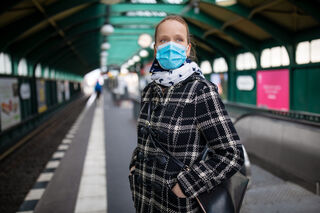Friends
COVID and College Students Home for the Holidays
How to talk about COVID safety with your college student.
Posted November 16, 2020

College students will be home soon for Thanksgiving and as much as parents will want to welcome them with open arms, they can’t, in fact, hug them. Not in the way they’d want. This is but the tip of the behemoth pandemic iceberg we all face. Parents are bracing themselves against uncertainties on every front: Are their kids bringing COVID home with them? Are they so stressed from another pandemic semester that if they don’t see their friends they’ll break? Can we even talk about COVID precautions or will that set the family time off on a bad foot?
Students, exhausted from navigating the all too real new frontiers of the emotional paradox of socially-distant college, are filled with feelings they’ve been keeping inside for months. Who could they talk to? They’re all struggling. On the one hand, they are aching to be home surrounded by the safe and familiar. But many are dreading it too, still haunted by last March and the protracted lockdown, the crumbling of life as they knew it, and fearing it will all happen again.
With the staggering spike in COVID cases and the devastating rise in hospitalizations and deaths, we can’t not talk about this.
Difficult, serious conversations need to happen about the when and how of a safe return: quarantining at home, what safe socializing can look like, how to mask up (over the nose, people! That’s where the virus thrives!). Hopefully, you’ve already started these discussions, but if not—please, parents, we have to do this. None of us want to. But we shouldn’t throw up our hands and say we don’t have control over our kids. That’s not responsible parenting and the stakes are too high. We need to talk with our kids. There are ways to be safer. There are ways to make these conversations more positive, collaborative, and productive. This is part of good parenting. We can’t be short-sighted—as citizens of the world, we have a duty to protect each other in this global pandemic. And we want to.
Yes, the holidays this year are going to be very different, and that is hard, but the choices will profoundly impact all the other years— it could mean a matter of life or death. Usually, when we speak in extremes like this, I am here, as an anxiety therapist, with my editing pen crossing out the extremes. But not this year. This is not a cognitive distortion that an anxiety therapist is wanting you to correct. This is real. As an epidemiologist at George Washington University said in a recent article, “Your perception of safety may not match reality.”
Often what makes conversations about serious topics so hard is our apprehension about them, our fears about being in an uncomfortable situation. In many ways, our fears about the conversation are separate from the conversation itself. Some parents may feel so afraid that a conversation like this is too much for their already stressed-out student, or they may even be afraid that their child will feel unwelcome if parents were to talk about how they need to test or quarantine, or not see friends or family. It may feel that way, but since none of us are trying to stress out our students, make that clear from the outset and have the conversation anyway. This is the hard part of parenting. You cheered their college acceptances, you’ve been with them every step of the way, so even though this wasn’t on anyone’s agenda, now is the time for all of us to step up.
Experts are saying:
- College students should quarantine at home. We’ve done it. It’s hard and sad, but not as hard and sad as someone getting sick or worse.
- Close up your COVID bubble and keep any gatherings small and outside.
- Mask up and masks up (over the nose): Make sure your student has masks and wears them properly.
- Outdoor gatherings only, preferably no eating together because that requires masks off.
Here are a few quick tips about how to have a successful COVID safety conversation:
Start where you want to end. Preface your conversation with the reason you are having it: “We love you, we care about you. We really want to see you, and we want you to connect with your friends, it’s all about the how and when of that. We care about everyone and we really want your help in making this work for everyone.”
Give your student credit and the opportunity to step up, use “we” language. As part of your preface, pay it forward and let your young adult child know that you know that they are caring and responsible and wouldn’t want to endanger anyone, and that you need to work together to make this work for all. Use “we” language and make it clear that we all basically want the same thing.
Manage your emotions and don’t rush. Important conversations can feel like an emergency. Yes, time feels short, but it’s going to be better to agree to put the conversation on pause and say out loud, “We don’t have to rush, let’s slow it down,” or agree to come back to it later. Be aware of your reactions and name them: If you do feel that “emergency feeling” like you have to blurt everything out or else, try to pause, step back and name the feeling to get distance from it. Say out loud: “I know pressure doesn’t help. I know I’m getting upset because I am afraid. I’m scared because I don’t want anything to happen to anyone. I’m upset that we are in this situation.”
Show your empathy. Your student is pandemic-exhausted, Zoom-exhausted, exhausted from so many compromises and concessions—understand that this is their starting point, and be kind and patient, even when that’s hard. Listen to their concerns and validate them. If you don’t understand or agree, rather than disagreeing, let them know that you want to understand and ask them to tell you more about it. Pay attention to their words, that will go a long way.
Do your research and know the facts. We can get emotional, but we also need to ground ourselves in the facts. Learn the “SMART” acronym below as a shortcut and starting point:
Make sure everyone knows the SMART acronym from our friends at @Dearpandemic:
S: Space: Keep your distance (6-10 ft)
M: Mask: Keep it on and over your nose!
A: Air: Fresh air is best
R: Restrict: Keep it small, close your pod or bubble to a just a few people you trust
T: Time: Keep it short! Limit indoor exposures to decrease your risk
There are many excellent articles offering an overview and specific recommendations for these confusing and stressful times. Read them as a family, and where appropriate, let each family member take responsibility for summarizing an article and sharing it with each other.
Here are some resources for specific questions that often come up:
- Why we should wait 3-5 days after possible exposure to get tested for COVID
- Why we shouldn’t be eating with people outside our pod or bubble
- Why half-masked (below the nose) increases the risk of COVID
- How to travel safely
- When to get tested if you’ve been in contact with someone with COVID
Invite and welcome their creativity and compromise. Once you've established the basics of COVID safety facts, ask your student what activities they have in mind or have heard of that are COVID safe: walks in the park, a fire pit in the backyard, stargazing in a field, a distance dance party with a few friends in separate sections of a park or parking lot. Listen to your student’s suggestions, give feedback in an encouraging way by first trying to find the good, then ask questions: “That sounds good that it’s a few friends in the backyard, but the food part—what can you do there to be safe?” Or, “That would be a great place to compromise—having it no food so masks stay on.” They may not need to go back to the drawing board completely, but just need to adjust their plans to protect everyone.
So, please, here we all are. If we are the country or the planet that “can’t say no,” when it comes to making necessary, smart, and life-saving decisions, what will happen? Let’s not find out. Alternatively, and positively, this is a “group project.” When students and parents realize we’re all working towards the same goal, on the other side of those tough days of putting food outside your student’s door while quarantining, etc., or skipping an extended family gathering, you’ll likely find that you become stronger and more connected as a family for it. And most of all— you and your family—and me and my family—will have prevented the spread of this terrible disease.
Thank you, everyone, for doing your part. Please share this article with that friend or family member who needs this nudge and reminder. Sending warmest Thanksgiving wishes to you and your family. Here’s to all of us working to end the pandemic and to less worry all around.
©2020 Tamar Chansky, Ph.D. A version of this post was also published here.




